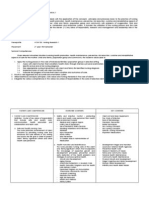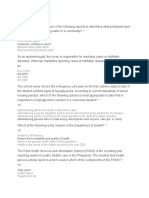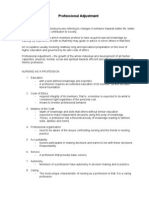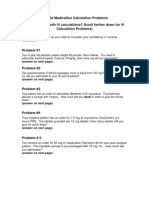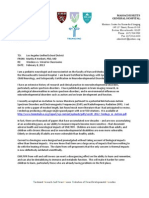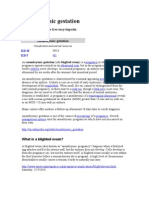0 ratings0% found this document useful (0 votes)
57 viewsPRELIMS - NCMA216 TRANS - Nursing Process in Pharmacology
PRELIMS - NCMA216 TRANS - Nursing Process in Pharmacology
Uploaded by
bnancajas7602valThe document discusses the nursing process in pharmacology. It includes the following key points:
1. The nursing process involves assessment, nursing diagnosis, planning, implementation, and evaluation to provide efficient nursing care through a nursing care plan.
2. Assessment involves gathering subjective and objective data from various sources including the patient, medical records, and diagnostic tests.
3. Nursing diagnosis identifies actual or potential health problems including their cause, signs, and symptoms. There are five types of nursing diagnoses.
4. Planning establishes prioritized goals and expected outcomes and determines appropriate interventions based on the patient's needs and behaviors.
4. Implementation carries out the planned interventions through independent, dependent, or collaborative nursing actions.
Copyright:
© All Rights Reserved
Available Formats
Download as PDF, TXT or read online from Scribd
PRELIMS - NCMA216 TRANS - Nursing Process in Pharmacology
PRELIMS - NCMA216 TRANS - Nursing Process in Pharmacology
Uploaded by
bnancajas7602val0 ratings0% found this document useful (0 votes)
57 views2 pagesThe document discusses the nursing process in pharmacology. It includes the following key points:
1. The nursing process involves assessment, nursing diagnosis, planning, implementation, and evaluation to provide efficient nursing care through a nursing care plan.
2. Assessment involves gathering subjective and objective data from various sources including the patient, medical records, and diagnostic tests.
3. Nursing diagnosis identifies actual or potential health problems including their cause, signs, and symptoms. There are five types of nursing diagnoses.
4. Planning establishes prioritized goals and expected outcomes and determines appropriate interventions based on the patient's needs and behaviors.
4. Implementation carries out the planned interventions through independent, dependent, or collaborative nursing actions.
Original Title
[5] PRELIMS_NCMA216 TRANS_Nursing Process in Pharmacology
Copyright
© © All Rights Reserved
Available Formats
PDF, TXT or read online from Scribd
Share this document
Did you find this document useful?
Is this content inappropriate?
The document discusses the nursing process in pharmacology. It includes the following key points:
1. The nursing process involves assessment, nursing diagnosis, planning, implementation, and evaluation to provide efficient nursing care through a nursing care plan.
2. Assessment involves gathering subjective and objective data from various sources including the patient, medical records, and diagnostic tests.
3. Nursing diagnosis identifies actual or potential health problems including their cause, signs, and symptoms. There are five types of nursing diagnoses.
4. Planning establishes prioritized goals and expected outcomes and determines appropriate interventions based on the patient's needs and behaviors.
4. Implementation carries out the planned interventions through independent, dependent, or collaborative nursing actions.
Copyright:
© All Rights Reserved
Available Formats
Download as PDF, TXT or read online from Scribd
Download as pdf or txt
0 ratings0% found this document useful (0 votes)
57 views2 pagesPRELIMS - NCMA216 TRANS - Nursing Process in Pharmacology
PRELIMS - NCMA216 TRANS - Nursing Process in Pharmacology
Uploaded by
bnancajas7602valThe document discusses the nursing process in pharmacology. It includes the following key points:
1. The nursing process involves assessment, nursing diagnosis, planning, implementation, and evaluation to provide efficient nursing care through a nursing care plan.
2. Assessment involves gathering subjective and objective data from various sources including the patient, medical records, and diagnostic tests.
3. Nursing diagnosis identifies actual or potential health problems including their cause, signs, and symptoms. There are five types of nursing diagnoses.
4. Planning establishes prioritized goals and expected outcomes and determines appropriate interventions based on the patient's needs and behaviors.
4. Implementation carries out the planned interventions through independent, dependent, or collaborative nursing actions.
Copyright:
© All Rights Reserved
Available Formats
Download as PDF, TXT or read online from Scribd
Download as pdf or txt
You are on page 1of 2
NCMA216
LESSON 5: NURSING PROCESS IN PHARMACOLOGY
WEEK 5 I SECOND YEAR, FIRST SEMESTER - PRELIMS | A.Y. 2023-2024 I COLLEGE OF NURSING - VALENZUELA CAMPUS
PPT and Discussed by: PROF. MARIVIC E. ILARDE, MAN, RN
Transcribed by: EDGARDO III T. BALAIS, SN I BSN 2-Y1-4 I OLFU - VAL
9. Weight: Helps to determine whether the
NURSING PROCESS recommended drug dose is appropriate.
10. Age: Influences pharmacokinetics and
● The problem-solving process used to provide efficient
pharmacodynamics; the immature liver may not
nursing care.
metabolize drugs in the same way as in the
● Involves gathering information, formulating a nursing
diagnosis statement, developing patient centered goals, adult.
carrying out interventions, and evaluating the process. ● Sources of Information:
1. Primary source: Produced by and from the
● Nursing Care Plan (NCP) - a document that provides
direction on the type of nursing care the individual, family, patient.
or community might need; facilitates standardized, 2. Secondary sources: Relatives, significant others,
evidence-based and holistic care. medical records, and lab reports.
3. Tertiary sources: literature to provide
STEPS OF THE NURSING PROCESS
background information, diagnostic tests, and
● ADPIE - stands for Assessment, Nursing Diagnosis, diet.
Planning, Nursing Intervention/Implementation, and
DIAGNOSIS
Evaluation.
● Statement of the actual or potential problem.
ASSESSMENT
● A complete nursing diagnosis consists of two or three
● Step of data-gathering. statements: (1) a statement of the patient's actual or
● Subjective Data (Patient) - Client symptoms are verbalized potential health problem, followed by (2) a statement of
by the patient; current health history, current medications, the problem's probable cause or risk factors, and (3) Sign
and past history. and symptoms.
● Example is: “Nahihilo ako”, “Masakit ang tiyan ko”. ● Five Types of Nursing Diagnosis:
● Objective Data (Observed by the nurse) - Check the 1. Actual: Based on human responses and
following: supported by defining characteristics.
1. Signs and those organs affected by the drug 2. Risk/high-risk: Patients may be more susceptible
therapy. to a particular problem.
2. Lab. Tests, such as Blood Chem. 3. Possible: Suspected problems requiring
3. Diagnostic Studies additional data.
4. Physical Assessment Results: Assess major body 4. Wellness: Clinical judgment about a transition
systems for any signs of reaction or interaction from one level to a higher level.
of drugs or signs of ineffective therapy. 5. Syndrome: Cluster nursing diagnoses that occur
5. Researching medication order: MIMS Monthly together and best addressed together.
Index of Medical Specialties, and Nursing Drug ● Examples are:
Handbook. - Knowledge deficit of disease and medication related to
● Comprehensive Collection of Data: inability to understand instruction.
1. History: The patient’s past experiences and - Risk for injury related to side effects of drugs (opioids,
illnesses that can influence a drug’s effect. antidepressants).
2. Chronic Conditions: Can affect the - Alteration in thought processes related to drug action
pharmacokinetics and pharmacodynamics of a (anti-anxiety drugs, antiseizure, narcotic painkillers).
drug. - Constipation related to drug action or side effects
3. Drug Use: may have an impact on a drug’s effect. (antispasmodic drugs).
4. Allergies: Past exposure to a drug or other - Fluid volume deficit related to drug action (diuretics,
allergens can provoke a future reaction. laxatives).
5. Level of Education and Understanding - Ineffective breathing pattern related to drug side effects
6. Social and Financial Support (ACE inhibitors, NSAIDS, anticonvulsants, beta blockers).
7. Pattern of Health Care: How he/she seeks health ● PES Format - Problem, Etiology, Signs and Symptoms
care gives info in preparing patient’s teaching (Example: Risk for injury related to side effects of the
plan. drug, evidenced by dizziness/lightheadedness and
8. Physical Examination: Develop a baseline for fainting).
evaluating the effectiveness of the drug.
NCMA216: PHARMACOLOGY LESSON 5: NURSING PROCESS IN PHARMACOLOGY 1
NCMA216
LESSON 5: NURSING PROCESS IN PHARMACOLOGY
WEEK 5 I SECOND YEAR, FIRST SEMESTER - PRELIMS | A.Y. 2023-2024 I COLLEGE OF NURSING - VALENZUELA CAMPUS
PPT and Discussed by: PROF. MARIVIC E. ILARDE, MAN, RN
Transcribed by: EDGARDO III T. BALAIS, SN I BSN 2-Y1-4 I OLFU - VAL
PLANNING PEDIATRIC COMPUTATION
● Prioritized goal setting or expected outcome. 1. Young’s Rule: For children over 1 year (or 12 months) of
● Plan which intervention to use based on anticipated age up to 12 years.
patient behavior. Formula:
● Four Phases of Goal Setting: Child’s dose = Age of child in years x Adult dose
1. Setting priorities: Identify problems and Age of child in years + 12
prioritize. 2. Clark’s Rule: Calculated according to the weight of the
2. Developing measurable goal/outcome child (in pounds or lbs.), therefore it can be used for
statements: Write short- and long-term goals for children of all ages.
the patient to be followed when providing care Formula:
(SMART objective). Child’s dose = Weight of child in lbs. x Adult dose
3. Formulating nursing interventions. 150
4. Formulating anticipated therapeutic outcomes. * 1 kg = 2.2 lbs
INTERVENTION/IMPLEMENTATION 3. Fried’s Rule: For children under 1 year of age (a month of
age to 11 months of age).
● Actions taken to meet the patient’s needs.
Formula:
● Nursing actions are suggested:
1. Independent action: Provided by nurse by virtue Child’s dose = Age of child in months x Adult dose
of education and license. 150
2. Dependent actions: Performed by a nurse based ADDITIONAL COMPUTATIONS
on a health care provider’s orders. ● DOSE (D/SxQ):
3. Interdependent actions (Collaborative): Doctor’s order/desired x Quantity
Implemented with the cooperation of a team. Stock on hand
● Three types of nursing interventions that are frequently ● IVF RATE (gtts/min or ugtts/min):
involved in drug therapy: drug administration, provision Volume in ml/cc x Drop Factor
of comfort measures, patient and/or family education. # hours to run 60 min/hr
● What to consider: * Drop Factor could be:
1. Proper Drug Administration: 10 Rights A. Macroset: 15 or 20 gtts/ml, or;
2. Comfort Measures B. Microset: 60 ugtts/ml
3. Placebo Effect: The anticipation that a drug will *1 macrodrop = 4 ugtts
be helpful. *Blood Transfusion = 10 gtts/ml
4. Managing adverse effects
5. Lifestyle Adjustment
6. Patient and Family Education
EVALUATION
● Determining the effects of the interventions.
● Met, unmet, or partially met.
● Effectiveness of health teaching about drug therapy
attainment of goals are addressed here.
● If goals are NOT MET, the nurse needs to determine the
reasons for this and REVISE THE PLAN accordingly, and
include additional ASSESSMENT data and the setting of
new GOALS (Side effects, adverse effects, and toxic
effects).
● If the goals are MET, the plan of care has been completed
(Therapeutic effects).
NCMA216: PHARMACOLOGY LESSON 5: NURSING PROCESS IN PHARMACOLOGY 2
You might also like
- AHA ACLS Megacode Scenarios PDFDocument6 pagesAHA ACLS Megacode Scenarios PDFNavin ShawnNo ratings yet
- NURSING PROCESS in DRUG THERAPYDocument4 pagesNURSING PROCESS in DRUG THERAPYMichiko CiriacoNo ratings yet
- SOFA (Sequential Organ Failure Assessment) and PELOD (Pediatric LogisticDocument5 pagesSOFA (Sequential Organ Failure Assessment) and PELOD (Pediatric LogisticvidyahamzahNo ratings yet
- School of Health and Allied Health Sciences Nursing DepartmentDocument2 pagesSchool of Health and Allied Health Sciences Nursing DepartmentJuviely PremacioNo ratings yet
- NCM 103 SyllabusDocument21 pagesNCM 103 SyllabuslouradelNo ratings yet
- Syllabus Dean OcoDocument16 pagesSyllabus Dean OcoChona SEVERANo ratings yet
- BulaloDocument7 pagesBulaloRobin HaliliNo ratings yet
- NCM 106 Midterm 1Document26 pagesNCM 106 Midterm 1JULIANNAH ATHENA MERCADONo ratings yet
- Pharmacokinetics Vs PharmacodynamicsDocument41 pagesPharmacokinetics Vs Pharmacodynamicsfarjanaislam mituNo ratings yet
- Pharmacology I Sample Questions - PharmacodynamicsDocument7 pagesPharmacology I Sample Questions - PharmacodynamicsAhmed ZiadNo ratings yet
- Syllabi (100-110)Document99 pagesSyllabi (100-110)Marilou PadilloNo ratings yet
- Repro Drugs - PharmaDocument5 pagesRepro Drugs - PharmaBulda, Princess Kaye R.No ratings yet
- NCM 103 Syllabus ObeDocument20 pagesNCM 103 Syllabus Obeۦۦ James100% (1)
- Pharma Prelim Assignment 1 - Pharmacodynamics..Document2 pagesPharma Prelim Assignment 1 - Pharmacodynamics..Kimberly Wyne SantosNo ratings yet
- 105 - Factors Influencing Drug ActionDocument4 pages105 - Factors Influencing Drug ActionCharisa Antonette HuelvaNo ratings yet
- Questions, Tfn.Document2 pagesQuestions, Tfn.Grace Panuelos OñateNo ratings yet
- Political Activism in Nursing Final PresentationDocument30 pagesPolitical Activism in Nursing Final PresentationDip Ayan MNo ratings yet
- NCM 107 Cmca LecDocument14 pagesNCM 107 Cmca LecAshitakaNo ratings yet
- CA 1 Resource UnitDocument8 pagesCA 1 Resource UnitPerlie Loren Arreo Cabatingan100% (1)
- Competency Checklist - Orientation and Annual PDFDocument3 pagesCompetency Checklist - Orientation and Annual PDFSyamsul ArifinNo ratings yet
- Funda OutlineDocument3 pagesFunda OutlineMeeKo VideñaNo ratings yet
- Pulido, Nathaniel T. (Quiz - Activity 6)Document2 pagesPulido, Nathaniel T. (Quiz - Activity 6)Nathaniel PulidoNo ratings yet
- 2 NCM119 A Patient Care Delivery System Sept. 2 2021Document6 pages2 NCM119 A Patient Care Delivery System Sept. 2 2021Ghianx Carlox PioquintoxNo ratings yet
- Handouts in NCM 119Document6 pagesHandouts in NCM 119Meliza BancolitaNo ratings yet
- CHN Long Quiz 2Document11 pagesCHN Long Quiz 2jovan teopizNo ratings yet
- CHN IntroDocument6 pagesCHN IntroApril Elenor Juco0% (1)
- Ca1 Pen SyllabusDocument6 pagesCa1 Pen SyllabusJoseph Bahian-AbangNo ratings yet
- Chapter 7: The Nursing Process in PharmacologyDocument5 pagesChapter 7: The Nursing Process in PharmacologyCHRISTINE JOY. MOLINANo ratings yet
- Behavioural Objectives: - Remedios H. Fernando, RN MANDocument100 pagesBehavioural Objectives: - Remedios H. Fernando, RN MANfleur harrison100% (1)
- DR Checklist Intrapartal CompetenciesDocument3 pagesDR Checklist Intrapartal CompetenciesRussel PamaNo ratings yet
- CHN Health PromotionDocument7 pagesCHN Health PromotionNareeza AbdullaNo ratings yet
- Antoine Narrative EDITEDDocument25 pagesAntoine Narrative EDITEDJewo CanterasNo ratings yet
- Professional Adjustment Final 2Document41 pagesProfessional Adjustment Final 2lielani_martinezNo ratings yet
- DARDocument4 pagesDARfritzroseNo ratings yet
- CHN 2 Course OutlineDocument2 pagesCHN 2 Course OutlineAlliyah MarieNo ratings yet
- NRS 2109 Revised Pharma Syllabus AY 2020 2021Document48 pagesNRS 2109 Revised Pharma Syllabus AY 2020 2021Julianne Kyla MercadoNo ratings yet
- Approach To BSN CurriculumDocument14 pagesApproach To BSN CurriculumCheska DillupacNo ratings yet
- Application of Ethical PrinciplesDocument3 pagesApplication of Ethical Principlesponce_0808No ratings yet
- Nursing Administration IVDocument10 pagesNursing Administration IVnurse_eccNo ratings yet
- Sample Evaluative ToolDocument5 pagesSample Evaluative ToolrlinaoNo ratings yet
- Sample Calculation Problems With AnswerDocument7 pagesSample Calculation Problems With AnswerStephen Gabriel BongolNo ratings yet
- Uterine Abnormality and DisplacementDocument22 pagesUterine Abnormality and DisplacementKinjal VasavaNo ratings yet
- Nursiing Management WR. Whole PackageDocument24 pagesNursiing Management WR. Whole Packageeyna30No ratings yet
- Teaching Plan HeadnursingDocument14 pagesTeaching Plan HeadnursingZed P. EstalillaNo ratings yet
- Community Health NursingDocument18 pagesCommunity Health NursingSteffanie BorjaNo ratings yet
- Virtual Hospital Practice Case Analysis-Ob Ward 2 SEM. SY: 2019-2020Document2 pagesVirtual Hospital Practice Case Analysis-Ob Ward 2 SEM. SY: 2019-2020Soleil MaxwellNo ratings yet
- 12Document13 pages12Tyson Easo JonesNo ratings yet
- Adult Health Nursing II Laboratory Course Syllabus 2020-2021Document52 pagesAdult Health Nursing II Laboratory Course Syllabus 2020-2021Hajer Alowaisi100% (1)
- Blood Glucose Levels For Obese Patients Have A Mean of 100 With A Standard Deviation of 15Document11 pagesBlood Glucose Levels For Obese Patients Have A Mean of 100 With A Standard Deviation of 15Kit RuNo ratings yet
- Commission On Higher Education Ched Memorandum Order NO. 30 Series of 2001 Subject: Updated Policies and Standards For Nursing EducationDocument34 pagesCommission On Higher Education Ched Memorandum Order NO. 30 Series of 2001 Subject: Updated Policies and Standards For Nursing EducationAngela SweetNo ratings yet
- NCM 106 Course SyllabusDocument9 pagesNCM 106 Course SyllabusEmmy100% (1)
- Carmela Or-Major-Circu-45Document4 pagesCarmela Or-Major-Circu-45MharaTootNo ratings yet
- Nle Test Plan: Nursing Practice IDocument14 pagesNle Test Plan: Nursing Practice IericNo ratings yet
- Imci UpdatesDocument37 pagesImci UpdateskristiandiorcapiliNo ratings yet
- Rubrics of The Recorded Health Teaching With Health PlanDocument2 pagesRubrics of The Recorded Health Teaching With Health PlanCiedelle Honey Lou DimaligNo ratings yet
- RLE Clinical RotationDocument2 pagesRLE Clinical RotationtwothumbsNo ratings yet
- Course SyllabusDocument3 pagesCourse SyllabusMarimel SevillaNo ratings yet
- The Ride of Your Life: What I Learned about God, Love, and Adventure by Teaching My Son to Ride a BikeFrom EverandThe Ride of Your Life: What I Learned about God, Love, and Adventure by Teaching My Son to Ride a BikeRating: 4.5 out of 5 stars4.5/5 (2)
- COMPREHENSIVE NURSING ACHIEVEMENT TEST (RN): Passbooks Study GuideFrom EverandCOMPREHENSIVE NURSING ACHIEVEMENT TEST (RN): Passbooks Study GuideNo ratings yet
- NURSING EMERGENCIES. 10 BASED TEST QUESTIONS WITH BIBLIOGRAPHYFrom EverandNURSING EMERGENCIES. 10 BASED TEST QUESTIONS WITH BIBLIOGRAPHYNo ratings yet
- Chronic Non-communicable Diseases in Ghana: Multidisciplinary PerspectivesFrom EverandChronic Non-communicable Diseases in Ghana: Multidisciplinary PerspectivesNo ratings yet
- Evidence Based Practice in Relation To Labor InterventionDocument19 pagesEvidence Based Practice in Relation To Labor Interventionnathsujitkr1980No ratings yet
- A PH Thous UlcersDocument23 pagesA PH Thous UlcersGindi Cinintia AsmarantakaNo ratings yet
- Konika Abstrak I Final (Edy Novery) - Compressed - Edy NoveryDocument5 pagesKonika Abstrak I Final (Edy Novery) - Compressed - Edy NoveryAdrian KhomanNo ratings yet
- Life Science English To Arabic Freelance TranslatorDocument8 pagesLife Science English To Arabic Freelance Translatormedhat444444No ratings yet
- Procedure ON Bladder Irrigation: SUBMITTED TO: Mr. EKE Lama TamangDocument17 pagesProcedure ON Bladder Irrigation: SUBMITTED TO: Mr. EKE Lama TamangRajaNo ratings yet
- WOCNews 10 Vol3Document23 pagesWOCNews 10 Vol3Agung GinanjarNo ratings yet
- Dr. Herbert Letter To LAUSDDocument2 pagesDr. Herbert Letter To LAUSDZack MarksNo ratings yet
- Scope of Community Health NursingDocument2 pagesScope of Community Health Nursingchuniadsuar100% (4)
- Question Unit II BP802Document26 pagesQuestion Unit II BP802Mr HarryNo ratings yet
- Medical License Lek Ldek MulDocument4 pagesMedical License Lek Ldek MulAlexandra & Raphael “A&R”No ratings yet
- Storage of Insulin: Idf Europe Awareness PaperDocument12 pagesStorage of Insulin: Idf Europe Awareness PaperIndri AuraliaNo ratings yet
- An Embryonic GestationDocument5 pagesAn Embryonic Gestationminmei_stuartNo ratings yet
- HOM Solanki Gaurav Top 3Document4 pagesHOM Solanki Gaurav Top 3ASHUTOSH GAMERNo ratings yet
- Genetic Disease Is A Common Cause of Bilateral Childhood Cataract in DenmarkDocument10 pagesGenetic Disease Is A Common Cause of Bilateral Childhood Cataract in DenmarkEvy Alvionita YurnaNo ratings yet
- Critical Tests & Critical ResultsDocument4 pagesCritical Tests & Critical ResultssehrNo ratings yet
- Holstege Publications 2014Document21 pagesHolstege Publications 2014Mr. FNo ratings yet
- E Ticket ReceiptDocument9 pagesE Ticket ReceiptSrinidhi ChandraguthiNo ratings yet
- Curiculum Vitae: Education: 1. Medical Faculty of University of Indonesia 1972 - 1978Document3 pagesCuriculum Vitae: Education: 1. Medical Faculty of University of Indonesia 1972 - 1978galih wicaksonoNo ratings yet
- Hypertension in Pregnancy PDFDocument397 pagesHypertension in Pregnancy PDFMary PrietoNo ratings yet
- Bandhan Bank Health Plus Portability 050723Document2 pagesBandhan Bank Health Plus Portability 050723goelrajivgNo ratings yet
- Scope of NursingDocument4 pagesScope of NursingIvy Jenica Mamuad100% (1)
- Pharma Module 4Document4 pagesPharma Module 4Chelsy Sky Sacan100% (1)
- Scribd PDF - Diabetic Teach PlanDocument7 pagesScribd PDF - Diabetic Teach PlanMeredith BarbNo ratings yet
- LAB 9 - Brucella TestDocument4 pagesLAB 9 - Brucella TestAS. AQNo ratings yet
- Pulpal Periapical DiagnosisDocument2 pagesPulpal Periapical DiagnosisJay PatelNo ratings yet
- Study of Regulatory Restrictions in The Field of PharmaciesDocument30 pagesStudy of Regulatory Restrictions in The Field of PharmaciesAnonymous hF5zAdvwCCNo ratings yet
- Chapter II-V-1-Splenectomy-Dr-Mark-MakaryDocument21 pagesChapter II-V-1-Splenectomy-Dr-Mark-MakaryMark MakaryNo ratings yet
- Apollo Hospital Press Release 5 02 Sept 14Document2 pagesApollo Hospital Press Release 5 02 Sept 14LUKAZA2013No ratings yet
- E-Portfolio SepsisDocument19 pagesE-Portfolio Sepsisapi-315727817No ratings yet


















